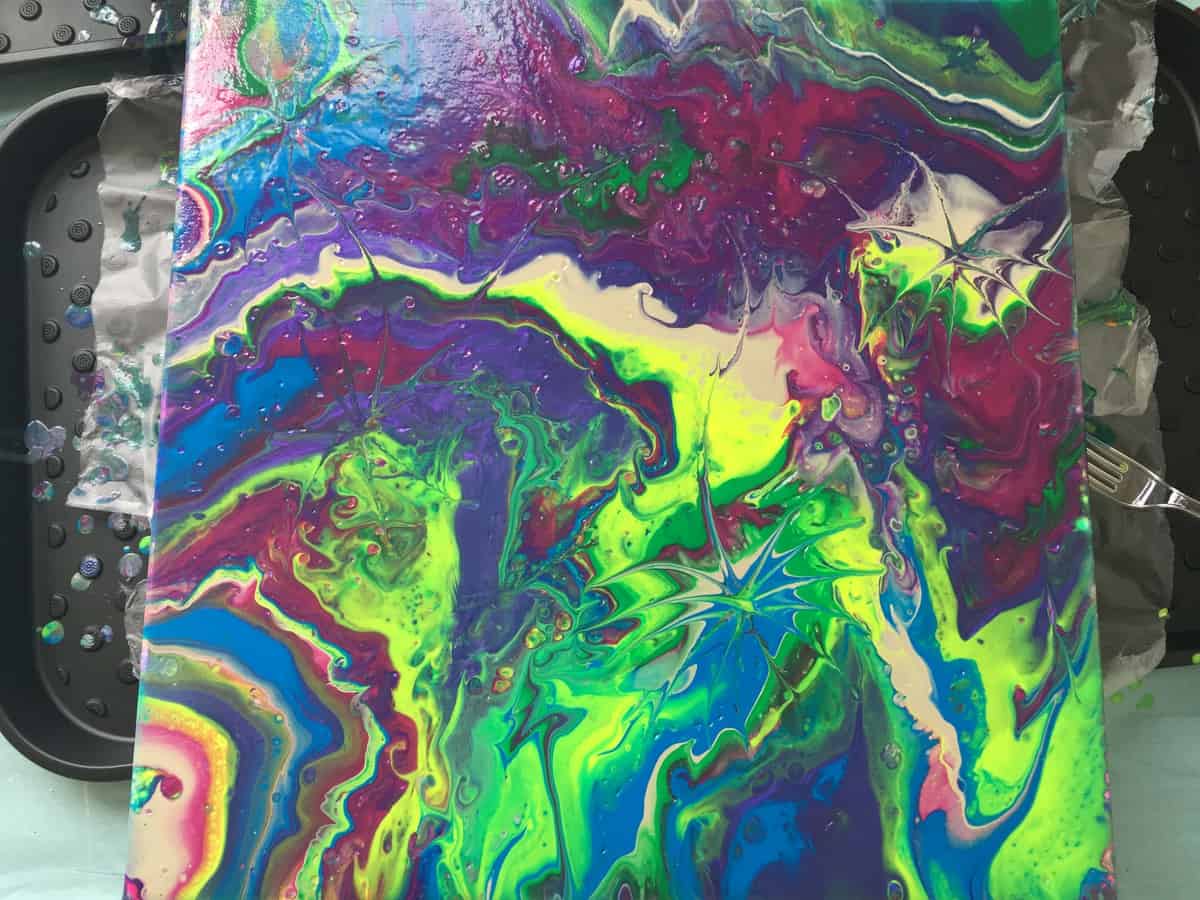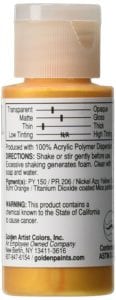When it comes to acrylic pouring, everyone asks about what medium to use, which paints are the best, and which additive gives the most cells. But rarely does anyone ask, How can I keep myself safe while painting?
Supplies I Used
- Disposable gloves
- Disposable or reusable face mask
- Non-toxic paints
Safety is an easy step to overlook if you’re stepping into the acrylic pouring world with minimal art experience. The first time I really stopped to think about it was when I bought a bottle of Golden brand cadmium yellow paint. I was admiring its beauty when a little label caught my attention.

At this point, I’d been trying to use gloves when I painted (mostly to not be as messy), but there were many times I would forget. My fingers and arms would be covered in paint. I had a nail brush in the bathroom to help me get the paint off my nail beds when I washed my hands.
I remember laughingly commenting with other users about paint on the hands being the “mark of a true artist.” I wasn’t really that worried about it, I mean, come on, everything is poisonous, everything causes cancer. Those Californians are probably being too picky. Let’s not stop living our lives, right?

Well, fast forward about six months and I’m sitting in front of the urologist being told that I have a bladder tumor, and that it must be removed and could be cancerous. I was in shock. I’m 34 years old, I have two young children, this didn’t make any sense.
While I waited through a week of nail biting agony after my surgery to find out if I had cancer, I went down a spiral of Google doom, learning all the many ways this tumor could have been caused, and I was in shock when I saw this:

“And paint products”. Baboom! My heart jumped into my throat when I read that.
Now, let me stop right here and point out that I am not a doctor or any sort of medical professional. But I am an educated adult capable of doing research and applying common sense to my basic scientific knowledge. And what I learned was eye-opening.
Here’s an excerpt from one article I read: “Some older paint pigments were made with materials now known to be toxic. The second group is pigments that may be toxic, either through prolonged contact, or if swallowed (actually easier than it sounds, especially if you chew on your brush handles or fingernails, or use watercolors.)”
The “cadmium” part of the yellow paint refers to the metal that was used to make it. From Wikipedia: “Cadmium was used for a long time as a corrosion-resistant plating on steel, and cadmium compounds are used as red, orange and yellow pigments, to colour glass, and to stabilize plastic. Cadmium use is generally decreasing because it is toxic (it is specifically listed in the European Restriction of Hazardous Substances[4])”.

So what’s the purpose of this article? Am I telling everyone to run and hide from your paints? No way. Even before I got the good news that my bladder tumor was benign, I was already planning my next painting.
I’m not even sure painting was the cause of my health issues. But the experience opened my eyes that I need to be more mindful of my health when using all these chemicals. In my opinion, we should be spending a bit more time when we’re prepping a painting session to ensure our own health as well as the beauty of our artwork.
Here are my three tips for safer painting:
- Wear gloves. And wear them for every painting session, including mixing paint. Since it takes so long to set up a session, I sometimes get too excited and forget my gloves. To help with this, I’ve started laying them out by all my supplies right away. I like these from Amazon. Make sure you get a size that’s big enough. If you’ve never tried on gloves before, order up. Wearing gloves that are too tight is painful.
*Tip for reusing gloves: Wash your hands in the sink while wearing them and hang to dry to get another use! - Paint in a room with ventilation. Inhaling paint fumes, torch fumes, resin fumes, they’re all toxic to our bodies. So work in a room that has ventilation. And if that’s not possible, invest in a mask. These can be found in disposable and reusable models that have filters you replace.
*Also remember that the fumes are affecting everyone else in the room as well. I try not to paint around my children unless I’m using non-toxic paint. - Look into non-toxic products. Take a look at the labels of your paints, additives, and mediums to get a better idea of the chemicals you’re coming into contact with. If you’re concerned, look into some non-toxic options like Earth Safe Finishes or this set on Amazon.
Above all, take care of yourself while painting so you can enjoy it as long as possible!
If you want to learn more, we have a great article that looks at the question: Is Acrylic Paint Safe for Skin?

Devin lives in Moscow, Russia, where she is an international teacher with her husband and two young children. She is an avid artist who loves acrylic pouring, photography, graphic design, and painting. She loves the relaxing therapy of art and looks forward to any chance she gets to sit down and create. Check her out at Oceans Apart Studios on Instagram and Youtube.

Wow, this is Elle from handmadepiece.com. I know acrylic paintings since we do this business. But for acrylic pouring artworks, it seems more fantastic and interesting. I would like to have a try.
That’s great, Elle! Hope you have fun experimenting and trying out this exciting art form.
Thank you for sharing your story. I am guilty of not wearing gloves – but NO MORE!!
Glad you found it helpful, Elizabeth! It’s always best to keep artists’ safety in mind, whichever art form we practice.
Thanks for the info.